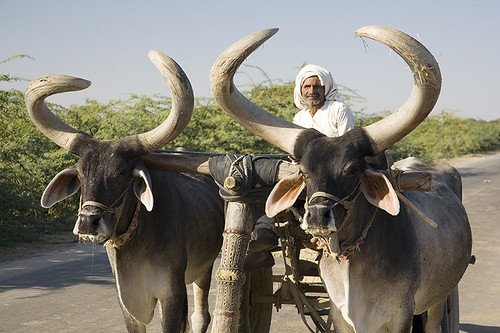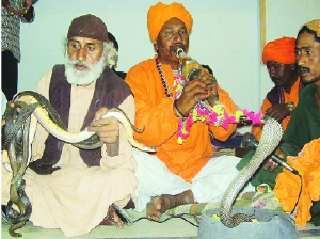
Baloch has a rich musical culture. Music has a significant role on all occasions except ceremonies of death. Most of the Balochi Music is based on Zaheerag which is a kind of melancholic music. The instruments used are mainly a flute, locally called Nal, Tamboora and Soroz. Thanksgiving dances are made of joy at the time of positive weather changes and harvests, which are collectively performed in groups. A special religious dance is carried out by a Baloch sect known as Chogaa. Another common Baloch folk dance is known as Dochaap. In this dance men gather and dance in groups, clapping hands with the movement of foot, neck and head with rhythmical music on drums. On various occasions, women also move in a circle clapping their hands. Other dances include the Lewa, which is thought to be of Arabic origin, along with Latti and Hambo said to be of ancient Balochi origin, are also very popular.
Balochi Chap in Iran
URL: http://www.youtube.com/watch?v=upoA-zrDGeY&p=7629C7EBEBBCBD81&playnext=1&index=14

Balochi music achieved an extraordinary development which is due in great part to a type of artist and artisan cast whose members are called Osta (master) and whose origins are unknown. The Ostas appeared among the Baloch tribes (particularly theRend), offering to put their music at the service of the tribes ancestral knowledge. Even if the Ostas occupy a modest position, they can at least boast of belonging to prestigious lineages of musicians.
Ziarekan by Sabzal Samigi
URL: http://www.youtube.com/watch?v=L8jftsL9tq4
In fact, there are reasons to think that they are the descendants of the Lulismentioned in the ancient chronicles. In these chronicles, a fifth-century Persian king asked an Indian king to send him musicians so that his subjects could listen to music while drinking their wine. Ten thousand Lulis were thus dispersed over the territory of Iran to put their talent at the service of the people.
Sabzal Samigi
URL: http://www.youtube.com/watch?v=dUS_Ip54vHs
It is impssible to verify whether these are the same tribes as those from which the present-day musicians of Balochistan are descended, which would make them descendants of the first Gypsies. In fact, there are many parallels between Balochi musicians and other groups who are also considered to comprise a part of the initial "Proto-Gipsy" nucleus, for example, certain Sindi groups and the castes of Langaw musician of Rajistan
Balochi Chaap [Folk Dance] as Mengal Perform it in Nushki
URL: http://www.youtube.com/watch?v=zLjquVmimgg&feature=related

Balochi Chap [Folk Dance] from Noshki - Balochistan
URL: http://www.youtube.com/watch?v=RdhFGhXNU4w&feature=related
Sabz Ali Bugti
URL: http://www.youtube.com/watch?v=tCWqW4OXT9c
Festive Songs
Feasts on the occasion of a marriage or circumcision are important social and cultural events in which music plays a large role. Wedding songs in genres called Salonk andNazenk for the groom and bride, respectively, belong to the most purely Balochi layer of the repertory, which also includes lullabies and funerary chants.
Each stage of the feast corresponds to particular songs. Marriages provide the occasion for singing both Sawts ----popular songs on themes of love and separation, and ghazals, which typically use learned Persian poetry. Most of these traditional songs can be performed by the participants, but these days, hosts prefer to invite a variety of instrumentalists and female vocalists----all amplified----to give more cache to the event.
Balochi Folk Song by Sabz Ali Bugti
URL: http://www.youtube.com/watch?v=EniqNa2hh1A
Even during the intimate ceremonies reserved for women, it is possible to engage a group of male musicians to animate the party. To describe all the stage of a complete wedding would take too long, but brief descriptions of a few of the central events will show how music in involved.
Laila O Laila by Late. Faiz Muhammad Baloch
Aye Naz Husn-e-Wala by Late. Faiz Muhammad Baloch
A wedding takes place several days and is announced in the street by performers playing the Sorna, a loud oboe, and Dohl, a drum. In the house of the bride (Banur) a curtain is drawn down the middle of a room, behind which the young woman remains for several days, tended to and fed by 8 or 10 women who are close to her.
Each evening the women feast, sing, and dance among themselves while playing theDohl and Kuzag, an earthen water jug. Meanwhile, the men have erected a high tent canopy (Tanbu) in the courtyard or in the street and pass the time singing and dancing under it. The first evening, the hands of the bride are decorated with henna (Enny) while the women sing songs (Nazenk) that correspond to this ceremony, as well as other songs. Another evening, they wash, make up, and apply perfume to the bride, all the while singing still other songs. The same scene takes place in the house of the groom
Masqat-e-Mairok by Late. Faiz Muhammad Baloch
Wash Gushi by Late. Faiz Muhammad Baloch
Nazenk are sung each time he is the object of a particular type of care. After several days, the groom is led to the house of the bride.
This procession provides the occasion for another musical interlude in the street with the groom. After the nuptial benediction, Nazenks are sung, and the party begins.
Kharmo Kay Bassonay by Akhtar Channal Zehri [Brahvi]
URL: http://www.youtube.com/watch?v=w7M8Q6eCU4o
Parkoi's Lado [Brahvi]
URL: http://www.youtube.com/watch?v=FQPl2SS_3zs
In present-day Baloch society, wedding songs are constantly being lost, and old musicians deplore the fact that nowadays most of the beautiful wedding song like theNazenk and Salonk have been forgotten, and people sing whatever they want at wedding ceremonies. Marriage songs are also practiced for feasts given at the time of a circumcision, and the term Salonk, which appears in most of the songs, designated both the groom and the young boy who is at the center of the festivity.
Baragh Baggi
URL: http://www.youtube.com/watch?v=V1MrKwPogl8&feature=related
Sabz Ali Bugti
URL: http://www.youtube.com/watch?v=_pdM_C-7Rw0&feature=related
ALE Lewa Lewa Balochi Dance of Mekran
URL: http://www.youtube.com/watch?v=dZjz6BNigBo
Secular Celebration and Trance Ritual
The performance of music for weddings or circumcisions can also assume the character of trance music through rhythmic acceleration and a narrowing of the melodic range. In this atmosphere, the music elicits bursts of joy and dance, bringing to mind the modes and rhythms of trance music, yet with different texts.
Balochi Chaap
URL: http://www.youtube.com/watch?v=_bMBNLov3B4&feature=related
Conversely, certain trance melodies are very close to secular repertories, particularly lullabies and Nazenk, or are simply borrowings, superficially adapted. Music for celebration can lead to a certain excitation and in return, trance music and ritual can animate a celebration. The bride and groom are pampered like a patient undergoing spirit exorcism, and the celebration ends with a good meal. Despite these affinities, however, the two repertories are quite distinct and never mixed together in a ritual.
Traditional Brahvi Jani Dastan Bandan
URL: http://www.youtube.com/watch?v=4ybVE1LgZXw&feature=related
Trance rituals reserve a central place for music, and integrate elements of shamanism with the traditions of popular Sufism. When someone becomes ill and cannot be healed by doctors, the person is taken to a Khalife (Shaman), and melodies are played which cause the khalife to enter into trance, and manages to treats the sick person, who often himself enters into trance, and manages to appease the evil spirit.Guati-Damali music can also be simply for pleasure, between friends, and without ritual
Brahvi Chap [Folk Dance of Balochistan]
URL: http://www.youtube.com/watch?v=xsdsUw71JU8
Kand maye jani kand Balochi song by Khadim Hussain Bugti
URL: http://www.youtube.com/watch?v=-Z_UBeCAaNk&p=011D6D5C30557B14&playnext=1&index=8
Brahvi Chap
URL: http://www.youtube.com/watch?v=epe6ia-wz2g&feature=related
Its melodies reflect a simple structure, but abundantly and skillfully ornamented, inspired by Sufi litanies (Zhikr) and the invocations of saints. One type of ritual reveals African stylistic influences: the spirits are of African origin, and certain of the melodies were composed by Balochi musicians of African origin.
Balochi Classic Biya Biya Dilbar by Mureed Buledi
http://www.youtube.com/watch?v=baKTuoiVKgU
Classic Balochi Love Song by Mureed Buledi
http://www.youtube.com/watch?v=ih0Gj7V8JTw
Musical Instruments and Rhythm
Preferred instrument of professional Balochi musicians is the Sorud, or fiddle. It is cut from a block of wood (Parpuk, sometimes Mulberry) in a complex shape which suggests a skull and whose soundboard consists of the skin of a gazelle or goat. It is strung with four strings played with a small bow whose sound is amplified by 6 or 8 sympathetic strings. All metered vocal and instrumental performance is accompanied by a rhythmic drone on the large lute called Tamburag, which has two strings, one of which is doubled. Its playing seems simple, but it contains many rhythmic subtleties.
Balochi Song Wash Mallay by Aziz Baloch
http://www.youtube.com/watch?v=bSNUtKaQ_Mk
The Benju or Benjo is a dulcimer fitted with a keyboard. It was originally a mere musical toy, but after important improvements made by Balochi craftsmen, it has become a regular part of the Balochi instrumentalism. The Balochi Benju is an imposing instrument----three or so feet in length, with a loud and brilliant sound, and a range of more than two octaves. It can reproduce any traditional style, and these days is found in Sindhi music as well.
The Doholak is a Tambur of Indian origin made from a tree trunk and shaped like a barrel about, 2-3 feet long, the two sides are decorated with skins linked together bystrings whose length can be adjusted, permitting the player to adjust the tension REFERENCE: Maqam; Musical Magazine (Quarterly) Summer & Autumn 1999 By: Ashraf Sarbazi Pages: 126 - 129 August 14, 2009 11:16 PM EDT http://www.balochmedia.org/content-67.html A CULTURAL ANTHROPOLOGY OF BALUCHIS August 12, 2009 07:49 PM EDThttp://www.balochmedia.org/content-53.html Knowing the facts about Balochi music, instruments, styles and masters http://balochistanmusic.blogsky.com/?PostID=17

















